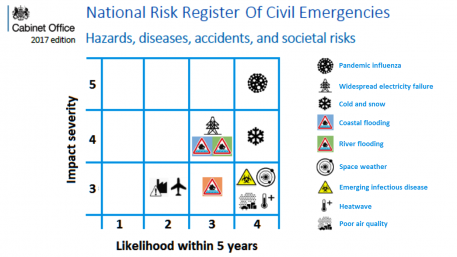What would really happen on Earth if a future big ‘space weather’ event were to occur? All of the latest academic and government reports indicate that ‘bad’ space weather poses a very serious threat to modern life. So the impact of bad space weather is not something just for astronomers, and everyone should be just as concerned about it as any other violent weather, especially when it would likely heavily impact key technologies like global satellite navigation systems and power networks right across the world.

All governments agree that another flu pandemic is the biggest risk to life on Earth, bearing in mind Spanish flu killed 50-100m people in 1918 and 1919*.
* ‘Spanish’ flu as it was first reported in the press there. It originated in Kansas.
After snow, space weather is regarded as the third biggest likely threat to human life. If a big solar flare and Coronal Mass Ejection occurred, it won’t necessarily head in the direction of the Earth. But if a massive solar pulse did hit us, it is potentially as damaging to society than most other natural events that occur on Earth like flooding, freezing weather and severe droughts.
Many governments haven’t yet accepted that space weather is a big risk, but it is 100% likely that a solar storm and CME as big as the 1859 Carrington event will hit Earth in the future. A massive solar pulse would affect transport and power systems, as well as most of the infrastructure of modern life.
Both the UK and US governments have stated in their official risk assessment reports of all natural and man-made threats that:
“The occurrence probability of an extreme space weather event is 6% to 10% within ten years.”
Those percentages may not seem high, but bear in mind thirty large solar pulses have occurred since Richard Carrington recorded the first one in 1859. So that’s one big pulse every five years or so. Accumulated over time, that makes the odds of a big pulse hitting Earth almost a certainty.
It means, statistically, anyone living to ninety will likely experience the effects of a big solar pulse. A sobering thought.
Solar pulses – financial risks and future threat response
The Carrington event of 1859 was the biggest solar pulse we are aware of that has actually hit the Earth. If it hit again now, the solar pulse, CME and geomagnetic storm would likely disrupt transport systems, create Geomagnetically Induced Current (GIC) in power lines, and impact multiple satellites, communication and GPS systems.
Take GPS and related technology. This has only really become popular since the mid-2000s. So until very recently, people and society hasn’t been anything like as reliant on smartphone GPS and car Satnav for GPS position and navigation data. So, if an 1859 sized event happened now, all of the negative effects would be multiplied much more severely, just on this one system alone.
You’d be right in thinking, therefore, that many governments around the world spend time and money on technology to monitor our sun.
Solar effects reveal their existence to us through multiple solar satellite telescopes, designed to pick up and record X-rays and other electromagnetic spectrums released from flares. We now know from these solar satellites that big solar flares do happen frequently, about once every five years. Interestingly, really big flares are not always during the sunspot maximum that occurs every eleven years. In fact they are about as unpredictable as any other type of weather we experience on Earth.
Looking at very recent solar pulse events, in December 2005 a solar storm generated X-rays that disrupted most satellite to ground communications and Global Positioning System (GPS) navigation signals around the world, for fifteen minutes. Then, in December 2006, a solar flare was recorded by the NASA NOAA GOES-13 satellite. This flare was so powerful that solar radiation permanently damaged the instrument that took its picture.
The big challenge in monitoring future solar storms is that many of our solar satellites are now well past their life expectancy, and urgently need replacing with new technology and system upgrades. The Parker Solar Probe has just been launched, but the development of many other solar satellites and probes have been delayed or projects cancelled.
The obvious issue is that solar science is not cheap, and politicians often prefer to pander to their citizens’ immediate knee-jerk concerns rather than to invest in predictive science. It only takes a quick glance at the news to see investment in critical new science and technology nearly always takes a back seat, to demands for short-term funding or government political agendas.
So is there a genuine risk from adverse space weather and solar superstorms? In the eighties there was a real wake-up call from the biggest space weather event outcome in modern times, the March 13 1989 geomagnetic storm. The source of the storm was a coronal mass ejection that left the Sun on 10th March, from a region that produced several large flares and CMEs. Solar monitoring programs had space weather forecasts available and telescopes monitoring the sun throughout the event.
This time it was Geomagnetic Induced Conduction (GIC) that had the greatest effect, seen in Quebec Canada as a geomagnetic storm. This triggered strong voltage fluctuations in the Hydro-Québec electricity grid, with voltage changes and rates of change so large they caused the grid’s protection system to be triggered, which led the whole electrical grid network to shut down within 90 seconds.
Six million people across Canada and into North America, who also used the hydro-electric electricity supply, were affected, with a significant economic cost to this shutdown. Many lessons were learnt by the electricity operators in these northern latitude at-risk locations. One of the reasons Quebec was particularly badly hit is that it is near the Earth’s magnetic north pole, the area where many of the most severe geomagnetic storm effects are experienced.
So should we be spending money on new solar monitoring systems, satellites and technology? Well it’s simple economics. The financial impact of a massive solar pulse has been carefully assessed by governments and many others who take it very seriously indeed.
In June 2013, a joint research venture from Lloyd’s of London and Atmospheric and Environmental Research (AER) in the United States estimated the current cost of the 1859 Carrington Event, if it happened again now. Using data obtained from the event they estimate the cost as being $0.6 to $2.6 trillion to the U.S. alone.
A January 2017 study by Cambridge University, the American Geophysical Union (AGU) and British Antarctic Survey found that two thirds of the US would be affected by power blackouts from a big solar pulse, with $42bn lost daily and half the losses occurring outside the blackout zone.
In April 2017 a UK report calculated the cost of the effects a five day loss of GNSS, the system that underpins GPS positioning, navigation and timing, which a big solar pulse would likely effect. The Innovate UK, UK Space Agency and Royal Institute of Navigation report estimates it would cost the UK economy alone £5.2 billion.
In May 2017, an ESA Space-Weather Socio-Economic Study assessed that if we do not invest in the ESA Space Situational Awareness Program, which includes essential new solar satellites, then the risk to the European economy is €13.1bn versus a cost of implementing the program of €530m, a six to one cost benefit ratio.
If we don’t start to take space weather seriously then we are destined to see the effects of scenes in this novel, soon, first hand.
If you’d like to know more about solar science and solar risks, then see the information in the Appendix and Reports and Links
